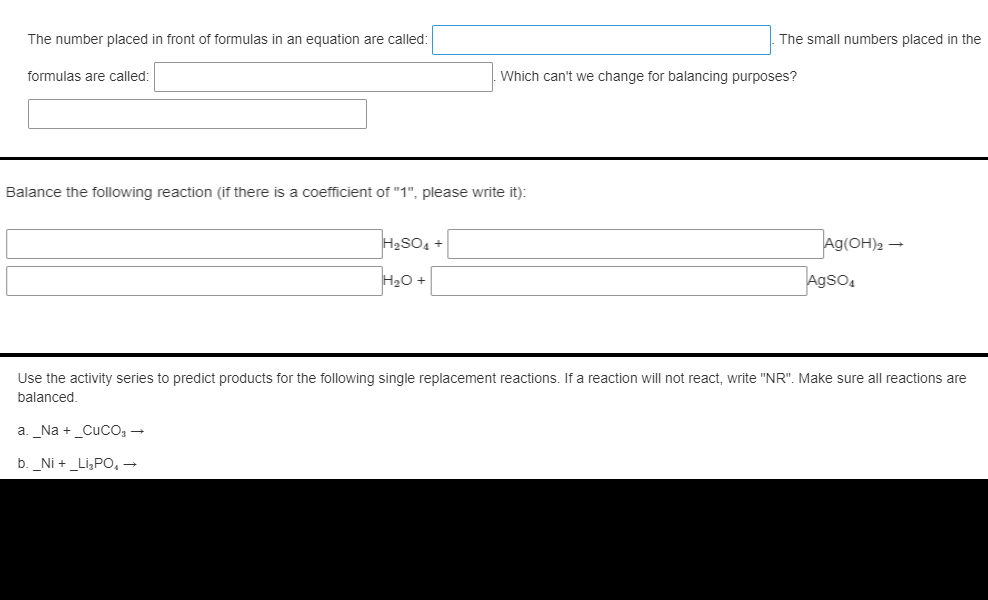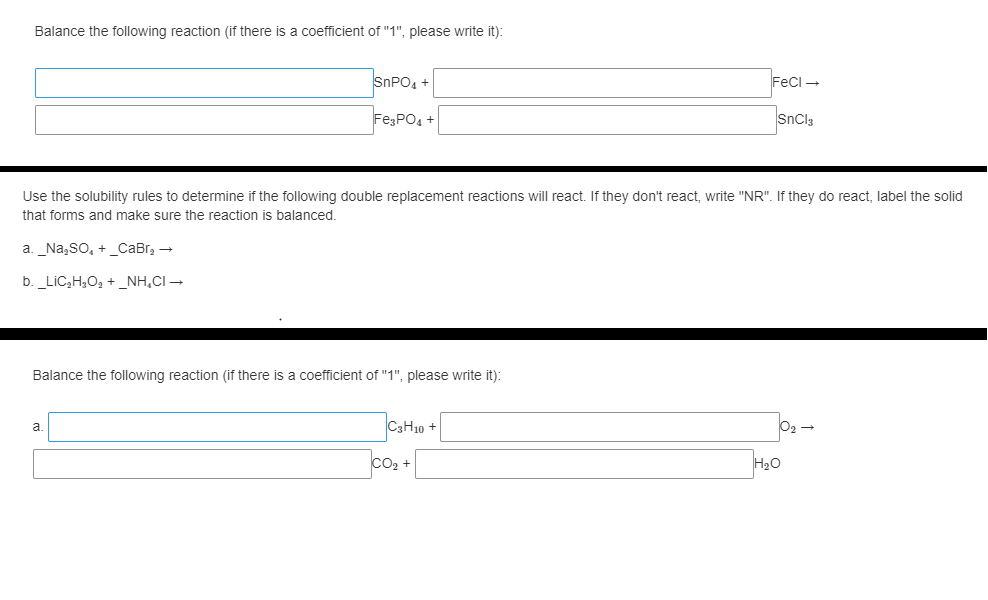The number placed in front of formulas in an equation are called: The small numbers placed in the formulas are called: Which can't we change for balancing purposes? Balance the following reaction (if there is a coefficient of "1", please write it): Ag(OH)a - Agso,
The number placed in front of formulas in an equation are called: The small numbers placed in the formulas are called: Which can't we change for balancing purposes? Balance the following reaction (if there is a coefficient of "1", please write it): Ag(OH)a - Agso,
Chemistry: The Molecular Science
5th Edition
ISBN:9781285199047
Author:John W. Moore, Conrad L. Stanitski
Publisher:John W. Moore, Conrad L. Stanitski
Chapter3: Chemical Reactions
Section: Chapter Questions
Problem 57QRT
Related questions
Question
100%

Transcribed Image Text:The number placed in front of formulas in an equation are called:
The small numbers placed in the
formulas are called:
Which can't we change for balancing purposes?
Balance the following reaction (if there is a coefficient of "1", please write it):
H2SO4 +
Ag(OH)2 -
H20 +
Agso,
Use the activity series to predict products for the following single replacement reactions. If a reaction will not react, write "NR". Make sure all reactions are
balanced.
a._Na +_CuCO, -
b. _Ni + _Li,PO, →

Transcribed Image Text:Balance the following reaction (if there is a coefficient of "1", please write it):
SNPO, +
Feci -
FE;PO4 +
SnCl3
Use the solubility rules to determine if the following double replacement reactions will react. If they don't react, write "NR". If they do react, label the solid
that forms and make sure the reaction is balanced.
a. _Na,so, +_CaBr, -
b. _LiCc,H,O, + _NH,CI →
Balance the following reaction (if there is a coefficient of "1", please write it):
CaH10 +
a.
Expert Solution
This question has been solved!
Explore an expertly crafted, step-by-step solution for a thorough understanding of key concepts.
This is a popular solution!
Trending now
This is a popular solution!
Step by step
Solved in 4 steps with 2 images

Knowledge Booster
Learn more about
Need a deep-dive on the concept behind this application? Look no further. Learn more about this topic, chemistry and related others by exploring similar questions and additional content below.Recommended textbooks for you

Chemistry: The Molecular Science
Chemistry
ISBN:
9781285199047
Author:
John W. Moore, Conrad L. Stanitski
Publisher:
Cengage Learning

Introductory Chemistry: A Foundation
Chemistry
ISBN:
9781337399425
Author:
Steven S. Zumdahl, Donald J. DeCoste
Publisher:
Cengage Learning

Chemistry: Matter and Change
Chemistry
ISBN:
9780078746376
Author:
Dinah Zike, Laurel Dingrando, Nicholas Hainen, Cheryl Wistrom
Publisher:
Glencoe/McGraw-Hill School Pub Co

Chemistry: The Molecular Science
Chemistry
ISBN:
9781285199047
Author:
John W. Moore, Conrad L. Stanitski
Publisher:
Cengage Learning

Introductory Chemistry: A Foundation
Chemistry
ISBN:
9781337399425
Author:
Steven S. Zumdahl, Donald J. DeCoste
Publisher:
Cengage Learning

Chemistry: Matter and Change
Chemistry
ISBN:
9780078746376
Author:
Dinah Zike, Laurel Dingrando, Nicholas Hainen, Cheryl Wistrom
Publisher:
Glencoe/McGraw-Hill School Pub Co

World of Chemistry, 3rd edition
Chemistry
ISBN:
9781133109655
Author:
Steven S. Zumdahl, Susan L. Zumdahl, Donald J. DeCoste
Publisher:
Brooks / Cole / Cengage Learning

Chemistry
Chemistry
ISBN:
9781305957404
Author:
Steven S. Zumdahl, Susan A. Zumdahl, Donald J. DeCoste
Publisher:
Cengage Learning

Chemistry: Principles and Reactions
Chemistry
ISBN:
9781305079373
Author:
William L. Masterton, Cecile N. Hurley
Publisher:
Cengage Learning